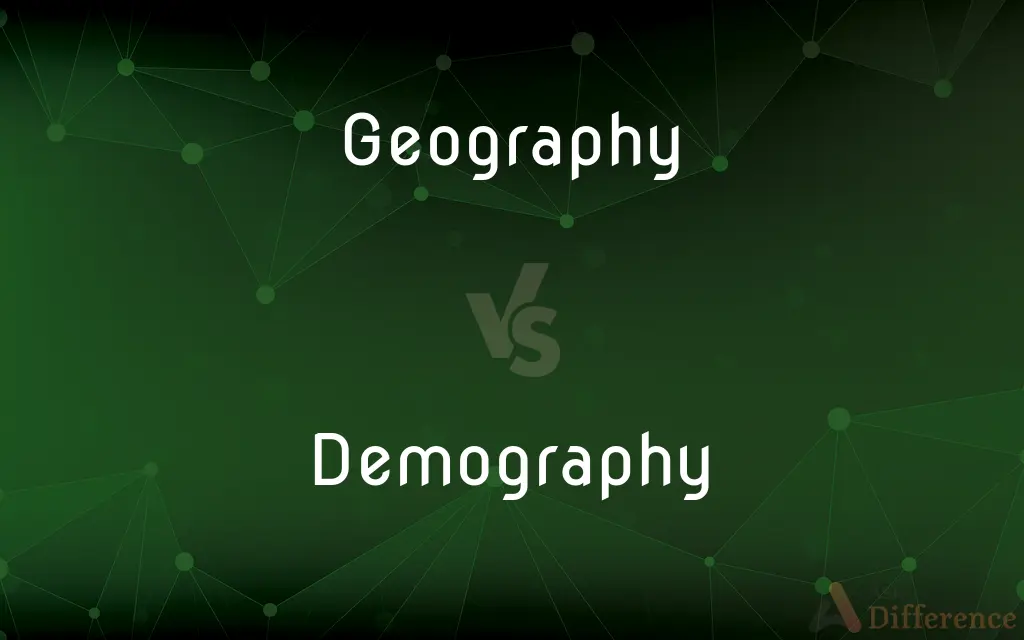Geography vs. Demography — What's the Difference?
By Tayyaba Rehman & Fiza Rafique — Updated on April 5, 2024
Geography studies the Earth's landscapes, environments, and physical boundaries, while demography focuses on statistical characteristics of human populations.

Difference Between Geography and Demography
Table of Contents
ADVERTISEMENT
Key Differences
Geography encompasses the study of the Earth's physical features, including mountains, rivers, and climates, as well as the interaction between human activities and the natural environment. Demography, on the other hand, concentrates on analyzing human populations, examining aspects like age, race, economic status, and population trends.
While geography provides insights into how physical landscapes influence human settlement, economic activities, and cultural practices, demography offers a detailed understanding of population dynamics, such as growth rates, migration patterns, and demographic changes. These insights are crucial for planning and policy-making in areas like urban development, healthcare, and resource management.
Geographers might explore how the distribution of natural resources affects regional development, or how climate change impacts human societies. Demographers, whereas, might investigate the implications of aging populations, fertility rates, or the socioeconomic factors influencing population health.
In practical applications, geography helps in disaster management, urban planning, and environmental conservation by mapping and analyzing physical and human-made features. Demography informs government and organizations about population needs, supports healthcare and social services planning, and aids in understanding labor market trends.
Despite their differences, geography and demography often intersect. For example, demographic data is crucial for geographers studying urbanization patterns, while demographic studies might consider geographical factors affecting population distributions and movements. Together, these disciplines provide comprehensive insights into human societies and their environments.
ADVERTISEMENT
Comparison Chart
Focus
Earth's physical features and human-environment interaction
Statistical study of human populations
Key Areas
Landscapes, climate, natural resources
Age, gender, race, migration, population growth
Applications
Urban planning, disaster management, environmental conservation
Policy-making, healthcare planning, market research
Analytical Methods
Spatial analysis, mapping, GIS (Geographic Information Systems)
Statistical analysis, population projections, surveys
Interdisciplinary Connections
Ecology, meteorology, sociology
Sociology, economics, public health
Compare with Definitions
Geography
Investigates how geographic factors affect global issues like climate change, migration, and urbanization.
Studying the geography of deserts helps understand patterns of human settlement and adaptation.
Demography
Relies on censuses, surveys, and population registers for data collection.
Demographers use census data to analyze trends in marriage and family planning.
Geography
The study of Earth's landscapes, environments, and the spatial relationships between humans and their environment.
Geography examines how the Nile River influenced the development of Egyptian civilization.
Demography
Examines trends such as migration, fertility rates, and life expectancy.
Demographers study how immigration patterns affect urban growth.
Geography
Includes physical geography (natural landscapes) and human geography (human societies).
The geography of the Amazon rainforest includes both its biodiversity and the cultures of its indigenous peoples.
Demography
The statistical study of human populations, analyzing their size, structure, and distribution.
Demography can predict how aging populations will affect a country's workforce.
Geography
Utilizes GIS, remote sensing, and cartography to analyze spatial data.
Geographers use GIS to track changes in land use and urban sprawl.
Demography
Essential for planning social services, healthcare, and education based on population needs.
Demographic studies inform government budgets for healthcare based on population age structures.
Geography
Influences urban planning and environmental policies by understanding spatial dynamics.
Coastal geography studies inform policies on climate change and sea-level rise.
Demography
Helps in understanding social changes and challenges related to population dynamics.
Demography sheds light on the socioeconomic factors contributing to declining birth rates in developed countries.
Geography
Geography (from Greek: γεωγραφία, geographia, literally "earth description") is a field of science devoted to the study of the lands, features, inhabitants, and phenomena of the Earth and planets. The first person to use the word γεωγραφία was Eratosthenes (276–194 BC).
Demography
Demography (from prefix demo- from Ancient Greek δῆμος (dēmos) meaning 'the people', and -graphy from γράφω (graphō) meaning 'writing, description or measurement') is the statistical study of populations, especially human beings. Demographic analysis can cover whole societies or groups defined by criteria such as education, nationality, religion, and ethnicity.
Geography
The study of the physical features of the earth and its atmosphere, and of human activity as it affects and is affected by these, including the distribution of populations and resources and political and economic activities.
Demography
The study of the characteristics of human populations, such as size, growth, density, distribution, and vital statistics.
Geography
The study of the earth and its features and of the distribution of life on the earth, including human life and the effects of human activity.
Demography
The study of the characteristics of human populations, especially with regards to their makeup and fluctuations and the social causes behind these.
Geography
The physical characteristics, especially the surface features, of an area.
Demography
The study of the structure and population dynamics of other lifeforms, such as mammals, insects, plants, etc.
Geography
A book on geography.
Demography
The particular demographic makeup of a population.
Geography
An ordered arrangement of constituent elements
Charting a geography of the mind.
Demography
The study of vital statistics, such as births, deaths, marriages, mortality, health, etc., in populations and subgroups of populations.
Geography
A description of the earth: a treatise or textbook on geography
Demography
The branch of sociology that studies the characteristics of human populations
Geography
An atlas or gazetteer.
Geography
The study of the physical properties of the earth, including how humans affect and are affected by them.
Geography
Terrain: the physical properties of a region of the earth.
Geography
Any subject considered in terms of its physical distribution.
Geography
Similar books, studies, or regions concerning other planets.
Geography
The physical arrangement of any place, particularly a house.
Geography
The lavatory: a room used for urination and defecation.
Geography
The relative arrangement of the parts of anything.
Geography
A territory: a geographical area as a field of business or market sector.
Geography
The science which treats of the world and its inhabitants; a description of the earth, or a portion of the earth, including its structure, features, products, political divisions, and the people by whom it is inhabited. It also includes the responses and adaptations of people to topography, climate, soil and vegetation
Geography
A treatise on this science.
Geography
Study of the earth's surface; includes people's responses to topography and climate and soil and vegetation
Common Curiosities
Can geography and demography help in addressing global challenges?
Yes, they provide insights into managing resources, planning for urban growth, and addressing issues like climate change and population aging.
How do geographers and demographers work together?
They collaborate on studies that require understanding the spatial distribution of populations and the environmental impacts of human activities.
What is the importance of GIS in geography and demography?
GIS enables the spatial analysis of demographic data and geographical features, aiding in effective planning and decision-making.
Are there any new fields emerging from the intersection of geography and demography?
Yes, fields like population geography and environmental demography examine the spatial aspects of population dynamics and their environmental implications.
What tools do demographers use to predict future population trends?
They use statistical models and projections based on current data on fertility, mortality, and migration rates.
Can demographic studies influence public health policies?
Absolutely, demographic research on population age structures, fertility rates, and mortality helps in planning healthcare services and interventions.
How do geography and demography influence each other?
Demographic trends are influenced by geographical factors like climate and resources, while population dynamics affect land use and environmental conditions.
What role does demography play in economic planning?
Demographic data informs economic policies by analyzing workforce trends, consumer behavior, and potential market changes.
Why is migration a key area of study in demography?
Migration significantly affects population structures, economic conditions, and social dynamics, making it crucial for planning and policy.
How do changes in the environment affect demographic patterns?
Environmental changes can lead to migration, alter settlement patterns, and impact population health and resources availability.
How can geography and demography aid in disaster preparedness?
They help in mapping risk areas, understanding population vulnerabilities, and planning evacuation and response strategies.
What is the significance of studying population aging in demography?
Understanding aging trends is vital for addressing future needs in healthcare, pensions, and social services, affecting economic sustainability.
How do geographic factors influence economic development?
Natural resources, terrain, and climate impact agricultural productivity, industrial location, and access to markets, affecting economic outcomes.
How does urban geography intersect with demography?
Urban geography studies the spatial aspects of cities and their development, incorporating demographic analysis to understand and plan for urban populations.
What challenges do geographers face in studying climate change?
Geographers must analyze complex data on climate patterns, human impacts, and predict future changes, requiring multidisciplinary approaches.
Share Your Discovery

Previous Comparison
Magazine vs. Booklet
Next Comparison
Department vs. UnitAuthor Spotlight
Written by
Tayyaba RehmanTayyaba Rehman is a distinguished writer, currently serving as a primary contributor to askdifference.com. As a researcher in semantics and etymology, Tayyaba's passion for the complexity of languages and their distinctions has found a perfect home on the platform. Tayyaba delves into the intricacies of language, distinguishing between commonly confused words and phrases, thereby providing clarity for readers worldwide.
Co-written by
Fiza RafiqueFiza Rafique is a skilled content writer at AskDifference.com, where she meticulously refines and enhances written pieces. Drawing from her vast editorial expertise, Fiza ensures clarity, accuracy, and precision in every article. Passionate about language, she continually seeks to elevate the quality of content for readers worldwide.













































